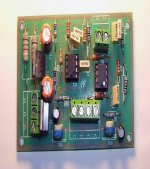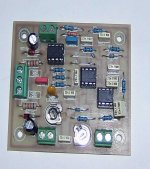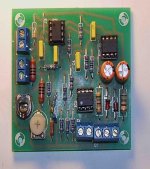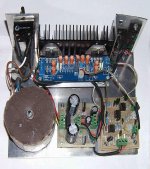I have been into Bi - amping for quiet some time. Here you have separate power amplifiers for the low frequency and high frequency. There are several advantages to bi –amping. The main are
1) No need for elaborate protection circuitry
2) Rise in the damping factor
3) Higher sound levels for the same input power
4) Easier to match the sensitivities of the woofer and tweeter. The woofer has different sensitivity from the tweeter and matching them is usually done by resistors which waste power.
5) Sound much better than the passive crossover amplifiers
6) Baffle diffraction equalization is easily done with a single op amp inserted in the filter chain
There are very few disadvantages one being the cost of two amplifiers .This has come down to very manageable levels
My first Bi amped amplifier
My first effort was an adaptation of a Elektor circuit for the filter a 3rd order Butter worth filter made with transistors driving TDA 2004 amps .This circuit was published in an Indian Electronics magazine
The block diagram of the Bi-amp is shown below
1) No need for elaborate protection circuitry
2) Rise in the damping factor
3) Higher sound levels for the same input power
4) Easier to match the sensitivities of the woofer and tweeter. The woofer has different sensitivity from the tweeter and matching them is usually done by resistors which waste power.
5) Sound much better than the passive crossover amplifiers
6) Baffle diffraction equalization is easily done with a single op amp inserted in the filter chain
There are very few disadvantages one being the cost of two amplifiers .This has come down to very manageable levels
My first Bi amped amplifier
My first effort was an adaptation of a Elektor circuit for the filter a 3rd order Butter worth filter made with transistors driving TDA 2004 amps .This circuit was published in an Indian Electronics magazine
The block diagram of the Bi-amp is shown below
Attachments
TDA7294 Biamp DIY-2
The cross over filters tried by me are :
I have experimented with the following active crossover filters
1) Sallen and Key 18 db /octave filter
2) Linkwitz reily 24 db/octacve and
3) State variable filter 24 db /octave crossover
Sallen and key filter
I adapted the circuit and made the PCB shown below in it,s populated form
Details
Board size 2”X3.5”
IC-TL072
Crossover frequency- 1500 cycles
Slope- 18db/octave
Input voltage- +- 15v to 35v DC
The cross over filters tried by me are :
I have experimented with the following active crossover filters
1) Sallen and Key 18 db /octave filter
2) Linkwitz reily 24 db/octacve and
3) State variable filter 24 db /octave crossover
Sallen and key filter
I adapted the circuit and made the PCB shown below in it,s populated form
Details
Board size 2”X3.5”
IC-TL072
Crossover frequency- 1500 cycles
Slope- 18db/octave
Input voltage- +- 15v to 35v DC
Attachments
Can you change the title of your thread?
There is ambiguity and as a result confusion in the use of the term Bi-amping.
I think you are referring to active speakers with active filters before the amplifiers.
Some might refer to this as active bi-amping.
Whereas using multiple amplifiers each to drive a single section of a passive crossover then to the speaker drivers could be referred to as Passive bi-amping.
Here in the UK, the more common terms are: active speakers and bi-amping of speakers.
There is ambiguity and as a result confusion in the use of the term Bi-amping.
I think you are referring to active speakers with active filters before the amplifiers.
Some might refer to this as active bi-amping.
Whereas using multiple amplifiers each to drive a single section of a passive crossover then to the speaker drivers could be referred to as Passive bi-amping.
Here in the UK, the more common terms are: active speakers and bi-amping of speakers.
TDA7294 Biamp-4
Which of the filters are the better of the three. Each of them have some advantages
Sallen & Key
1) Small PCB
2) All resistors and capacitors determining the frequency have equal value and hence easy to procure
Linkwitz reilly
1) Has baffle diffraction,all pass filter and is 24db/octave
2) The best sounding of all three
State variable filter 24db/octave
1) Adjustment of the frequency is dependent on only four resistors
2) Can adjust for the hump occurring at the crossover frequency
Which of the filters are the better of the three. Each of them have some advantages
Sallen & Key
1) Small PCB
2) All resistors and capacitors determining the frequency have equal value and hence easy to procure
Linkwitz reilly
1) Has baffle diffraction,all pass filter and is 24db/octave
2) The best sounding of all three
State variable filter 24db/octave
1) Adjustment of the frequency is dependent on only four resistors
2) Can adjust for the hump occurring at the crossover frequency
Hopefully you are aware that the crossover frequency, baffle step and delay should all be designed depending on the actual drivers and enclosure specifics. You can't just use whatever you feel like for optimum results, and unless you do your maths and measurement right, you won't be able to do any meaningful comparison between the crossover types.
Other that that, if you are looking for optimum on-axis response, your best bet would be Linkwitz-Reilly as it provides proper acoustic summing, ASSUMING the proper crossover frequency and if necessary all-pass delay has been used (although it's better to mechanically put the acoustic centers of the speakers at proper distances than use electronics to fix this), also for proper frequency response baffle step must be considered and this depends almost entirely on the width of the enclosure. All that being said, it's not the optimum crossover for all speaker types and uses.
It might also interest you that there is a kind of state-variable derived crossover that has 'perfect' phase and impulse response once the signals undergo proper acoustic summing. It was published by National Semiconductor in one of their application notes, IIRC you can still find this on the net. This crossover works very well but requires careful selection of drivers and optimization of their positions on the enclosure - it works particulairly well with coincident drivers, such as the KEF uni-Q series and other similar co-axial types.
Other that that, if you are looking for optimum on-axis response, your best bet would be Linkwitz-Reilly as it provides proper acoustic summing, ASSUMING the proper crossover frequency and if necessary all-pass delay has been used (although it's better to mechanically put the acoustic centers of the speakers at proper distances than use electronics to fix this), also for proper frequency response baffle step must be considered and this depends almost entirely on the width of the enclosure. All that being said, it's not the optimum crossover for all speaker types and uses.
It might also interest you that there is a kind of state-variable derived crossover that has 'perfect' phase and impulse response once the signals undergo proper acoustic summing. It was published by National Semiconductor in one of their application notes, IIRC you can still find this on the net. This crossover works very well but requires careful selection of drivers and optimization of their positions on the enclosure - it works particulairly well with coincident drivers, such as the KEF uni-Q series and other similar co-axial types.
Last edited:
Forget the discussion about Optimum Filter. As ilimzn alsready mentioned driver SPL and BS must be accounted for in teh filter. It is the acoustic (=driver+filter) filterd output that is supposed to have a LR , BUT or whatever chosen characteristic.
Electrically perfect LR (or BUT or whatever filters produce horrendous results when combined with real drivers in a real enclosure.
So get the combined responses right firstly, which is a formidable task in itself, before discussing various topologies.
Frankly speaking, it is a mystery to me how people can claim active filtering sounds better than passive.
Good Luck
Eelco
Electrically perfect LR (or BUT or whatever filters produce horrendous results when combined with real drivers in a real enclosure.
So get the combined responses right firstly, which is a formidable task in itself, before discussing various topologies.
Frankly speaking, it is a mystery to me how people can claim active filtering sounds better than passive.
Good Luck
Eelco
Forget the discussion about Optimum Filter. As ilimzn alsready mentioned driver SPL and BS must be accounted for in teh filter. It is the acoustic (=driver+filter) filterd output that is supposed to have a LR , BUT or whatever chosen characteristic.
Electrically perfect LR (or BUT or whatever filters produce horrendous results when combined with real drivers in a real enclosure.
So get the combined responses right firstly, which is a formidable task in itself, before discussing various topologies.
Frankly speaking, it is a mystery to me how people can claim active filtering sounds better than passive.
Good Luck
Eelco
BiAmp (Bi-Amplification - Not Quite Magic, But Close) - Part 1
Bi Amping
Unfortunately, You (and RE for that matter) are missing the point;:filtering -be it active, passive or active DSP- it is not about electrical filter responses, but acoustic output.
Acoustic aoutput is the driver-in-box-response-plus-filter-output. To dimension an active filter that, combined with a raw driver, produces even an acceptable LR 4 output is already quite a task, because we are talking non-standard electrical pass and stopbands.
Have a look at the LinearX wesbite at the LEAP tutorials to get a bit of a hang of it. Forget about RE: it is only half the story.
Good Luck,
Eelco
Unfortunately, You (and RE for that matter) are missing the point;:filtering -be it active, passive or active DSP- it is not about electrical filter responses, but acoustic output.
Acoustic aoutput is the driver-in-box-response-plus-filter-output. To dimension an active filter that, combined with a raw driver, produces even an acceptable LR 4 output is already quite a task, because we are talking non-standard electrical pass and stopbands.
Have a look at the LinearX wesbite at the LEAP tutorials to get a bit of a hang of it. Forget about RE: it is only half the story.
Good Luck,
Eelco
- Status
- Not open for further replies.
- Home
- Amplifiers
- Solid State
- TDA7294 Bi-amp DIY



